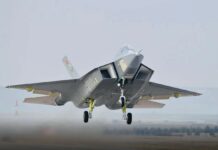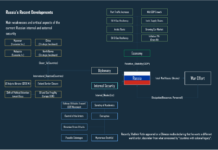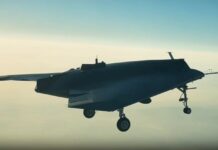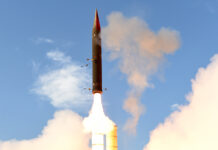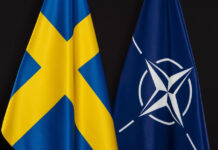Turkish Aerospace has brought the prototypes of its two future jet platforms – the TF-X future fighter and the Hürjet advanced jet trainer – out into the open for the first time.
Turkey’s Defence Industry Agency (Savunma Sanayii Başkanlığı (SSB) posted a series of photos on its website on 17 March 2023 showing the TF-X, which the SSB also refers to as the National Combat Aircraft (Milli Muharip Ucak –MMU), on the runway at Turkish Aerospace’s facility 20 km northwest of Ankara, where construction of the aircraft is taking place. This was a day in advance of when the company originally said the TF-X would first emerge from the hangar.
Then, the following day, the SSB posted a video of the Hürjet conducting taxi trials at the same location. It was unclear from the still images whether the TF-X had also conducted taxi trials, although Turkish press reports claimed that it had.

In mid-2022 Turkish Aerospace planned to conduct the maiden flight of the Hürjet on 18 March 2023, but the devastating earthquake that struck Turkey and Syria on 6 February has inevitably delayed the programme.
Meanwhile, Temel Kotil, CEO of Turkish Aerospace, stated in a 9 January 2023 interview with CNN Turk that he was optimistic the TF-X could make its maiden flight about two years ahead of schedule.
“We were planning to make the first flight of the National Combat Aircraft in 2025,” he said, “but my teammates were surprised. We took the flight forward.”
That statement was, of course, made prior to the 6 February earthquake, but 2023 is the centenary year of the founding of the Republic of Turkey on 29 October 1923, meaning that significant efforts will be made to mark the occasion with a significant development.

The TF-X future fighter is particularly important to the Turkish Air Force following Turkey’s 2019 ejection from the US-led F-35 Joint Strike Fighter programme for refusing to abandon acquisition of the Russian S-400 air defence system. Billed as a fifth-generation multi-role fighter, the TF-X is designed to have a maximum speed of Mach 1.8, a service ceiling of 16,764 M (55,000 ft), and g limits of +9 to -3.5 g. It is expected to serve with the Turkish Air Force, replacing its ageing fleet of F-16s, until the 2070s.
The Hürjet is designed to have a maximum speed of Mach 1.4, a service ceiling of 13,716 m (45,000 ft), a climb rate of 39,000 ft/minute, a range of 2,222 km and a payload capacity of 2,721 kg. As well as being positioned as an advanced jet trainer to train fifth-generation fighter pilots, the Hürjet is designed to replace older jets such as the T-38 and F-5 as well as operate as a light attack platform.
Peter Felstead




